#bbc verify
Explore tagged Tumblr posts
Text
by David Collier
BBC Verify is promoted as BBC’s flagship ‘fact checking’ news service. But as you will see below – BBC Verify is a cheap, amateurish, propaganda device- that is driven by unacceptable bias, and publishes blatant lies worthy of a Russian Soviet era misinformation service.
BBC Verify ‘verifies’ the Iranian missile strike
On Tuesday evening, 1 October 2024, Iran fired approximately 180 ballistic missiles at Israel. Many were intercepted, but several sites were hit. On Wednesday evening BBC Verify published a 1 minute 20 second video – titled ‘where Iran’s missiles struck in Israel’.
The BBC Verify team tells us they have been looking at ‘where Iran’s missiles have landed’ and the video is to counter ‘a lot of false imagery’ being circulated online. They say they managed to verify strikes in the vicinity of three key locations – all of them military sites:

This creates an immediate problem. Why only these three? For example, a verified strike by Ramat Gan shopping mall has not been included. The BBC had reported on this – and so were well aware of it – but for some reason, BBC Verify left the shopping mall strike out of their analysis.
It is difficult to escape the conclusion that BBC Verify were deliberately pushing a pro-Iranian propaganda line that the missiles were fired only at military targets.
But it gets a lot, lot worse.
66 notes
·
View notes
Text
by David Collier
It now looks likely that Israel successfully eliminated Mohammed Sinwar and other leaders of Hamas in a targeted strike last week. Which leaves the BBC flagship unit ‘BBC Verify’ looking increasingly like an anti-Israel disinformation machine.
The BBC Verify video on the ‘Gaza hospital strike’
On Tuesday afternoon (13 May 2025) Israel targeted key figures of the Hamas leadership who were hiding in a command centre beneath hospital grounds in Gaza. By Wednesday afternoon BBC Verify had turned the event into another opportunity to spread pro-Hamas propaganda.
The video the BBC Verify team published was all about how terrible Israel is – and carried footage showing how some civilians were almost certainly killed in the Israeli strike. But nothing at all in the video is really disputed at all – so just what did BBC Verify need to mobilise to check?
War is an awful thing – and having a clip of civilian casualties from the deadly strike as the Israeli ‘bunker-busting’ weaponry struck through at ground level near the entrance to the hospital was certainly worth covering in a news bulletin as *PART* of the wider story of Hamas turning hospital grounds into legitimate military targets. But it is not *THE STORY*. Because if Israel is right about Hamas leadership hiding underneath – and it looks as if Israel was right – then that changes EVERYTHING.
The obsessive, amateur activists of BBC Verify
We rarely get a more blatant misuse of BBC resources than this. There was only one issue about the Israeli strike that needed open source ‘verification’. And that is whether Mohammed Sinwar and / or other Hamas leaders were using hospital grounds as cover, or not.
If they were, then the only story in town was about Hamas being caught committing war crimes, removing the ‘do not touch’ exemptions from the hospital, and placing innocent civilians at risk.
And if that could not be verified at the time – and it couldn’t – then the only thing BBC Verify has shown by prematurely addressing the action, is that the unit is staffed by immature hacks who are more interesting in childish propaganda than acting in a professional manner. They had obviously seen (in an IDF post about the incident they claim is errant, along with the footage of the civilian damage) enough for them to string together a demonising post about Israel – which is what their entire piece is about.
But that is not what BBC Verify is supposed to be doing. BBC Verify is meant to be a fact-checking unit. And so it comes back to this – the ONLY fact that matters here is whether the Israelis are right or wrong about the Hamas command post. Did BBC Verify address this and answer that question? No, they did not.
14 notes
·
View notes
Text
#bbc verify#smuggler#human smuggling#migrant smuggling#united kingdom#migrant boat#atlantic migrant voyage#migrant deaths#Fadi Gujjar
2 notes
·
View notes
Text
Trump-Ramaphosa Clash: Fact-Checking White Farmer Genocide Claims
Introduction Former President Donald Trump’s recent meeting with South African President Cyril Ramaphosa took an unexpected turn when Trump presented controversial evidence of a so-called “white farmer genocide” in South Africa. The Oval Office encounter — initially cordial — shifted dramatically after Trump showcased videos, articles, and claims that have long circulated among his supporters…
#BBC Verify#Cyril Ramaphosa#EFF South Africa#fake news#farm attacks#genocide claims#Julius Malema#Kill the Boer#Ramaphosa#South Africa#TAU statistics#Trump#Trump Africa#white farmer killings
0 notes
Text
Posting screenshots from The Raggy Dolls every day until ITV puts it on ITVX: Day 27:

#i feel like svt has all the episodes on their equivalent of bbc iplayer#but i can't access it because im not Swedish#can anyone who lives in Sweden verify whether or not its on there for me???#would save me getting a vpn for what could be no reason#the raggy dolls#hi-fi
2 notes
·
View notes
Text
my life would be so much better if my stremio actually had decent torrent sources but no it works on everything except for my fucking phone and I'm not gonna watch my queer ass fantasy shows on the family tv
#i just wanna watch good omens without having to search for a goddamn webbed site that actually fucking works#and like. warrior nun. and these cool looking scifis. and fantasy shows i cant remember right now#like thank god bbc iplayer doesn't verify if you had a tv license because i fucking dont and the amount of doccy who/torchwood i watch#anyway
2 notes
·
View notes
Text
Israeli army admits to Gaza strike after BBC Verify investigation
[spintax]🚀 Trending Now:[/spintax] Israeli army admits to Gaza strike after BBC Verify investigation [spintax]Published|Originally posted[/spintax] on: [spintax]this site [random_words] 👉 [spintax]Highlights:[/spintax] [excerpt] ✍️ Full Content: [content] — 🔁 [spintax]Bookmark us for more updates at [spintax]YourNewsHub! 📰 Source: [source_url]
0 notes
Text
BBC Verify or BBC Very-Fiction? The Quiet Censorship Undermining Democracy
Who’s checking the fact-checkers at the BBC? And how many times, one wonders, has Auntie quietly edited the truth into submission—without so much as a whisper to the viewer? Because that, dear readers, is exactly what seems to have happened yet again. The national broadcaster, old Auntie Beeb, who once brought Churchill into living rooms and taught children the weather in rhyming verse, has once…

View On WordPress
0 notes
Text
How Elon Musk Amplified a False Memo Claim, Spreading Misinformation Elon Musk has recently drawn criticism for his online accusations against former UK Prime Minister Gordon Brown concerning grooming gangs. The claims Musk amplified are based on a debunked narrative regarding a Home Office memo purportedly issued 17 years ago. BBC Verify’s investigative research has dismantled these allegations,…
#BBC Verify investigation#Elon Musk misinformation#grooming gang allegations#Home Office memo#social media accountability
0 notes
Text
by Hadar Sela
On January 30th the BBC News website published a report by BBC Verify headlined “At least half of Gaza’s buildings damaged or destroyed, new analysis shows”.

“More than half of Gaza’s buildings have been damaged or destroyed since Israel launched its retaliation for the Hamas attacks of 7 October, new analysis seen by the BBC reveals.
Detailed before-and-after imagery also shows how the bombardment of southern and central Gaza has intensified since the start of December, with the city of Khan Younis bearing much of the brunt of Israel’s military action. […]
Across Gaza, residential areas have been left ruined, previously busy shopping streets reduced to rubble, universities destroyed and farmlands churned up, with tent cities springing up on the southern border to house many thousands of people left homeless. […]
Further analysis, by BBC Verify, reveals the scale of destruction of farmland, identifying multiple areas of extensive damage.”
The information concerning buildings comes from sources who have previously worked with other media outlets to produce similar reports.
“Now, satellite data analysis obtained by the BBC shows the true extent of the destruction. The analysis suggests between 144,000 and 175,000 buildings across the whole Gaza Strip have been damaged or destroyed. That’s between 50% and 61% of Gaza’s buildings.
The analysis, carried out by Corey Scher of City University of New York and Jamon Van Den Hoek of Oregon State University, compares images to reveal sudden changes in the height or structure of buildings which indicate damage.” [emphasis added]
An important clarification concerning that highlighted wording – which is not provided to readers of the BBC Verify report – was given to CAMERA by Jamon Van Den Hoek in late December:
“When we double-checked with the researchers, Van Den Hoek reiterated that they only count structures as “likely damaged or destroyed” because, he explained, “we don’t yet have means of distinguishing categories of damage severity.””
Notably, three days after BBC Verify’s report appeared, the United Nations Satellite Centre – UNOSAT – published its own “assessment of the damage and destruction inflicted on structures in the Gaza Strip” which concluded that 30% (rather than 50% to 61% as claimed by the BBC) of the structures in the territory have been damaged since the beginning of the war. The breakdown given in that report states that 22,131 buildings (9.6% of the total number of structures) have been destroyed, 14,066 (6.1% of the total number of structures) severely damaged and 32,950 (14.3% of the total number of structures) moderately damaged.
The BBC Verify report presents several ‘case studies’, beginning with Khan Younis:
“The southern city of Khan Younis has been particularly badly hit in recent weeks, with more than 38,000 (or more than 46%) of buildings now destroyed or damaged, according to the analysis. Over the past fortnight, more than 1,500 buildings have been destroyed or damaged there.
Al-Farra Tower – a 16-storey residential block in the centre of the city, the tallest building in the area – was flattened on 9 January as can be seen in before-and-after images of the city’s skyline. Much of the neighbourhood in which it sits has been levelled by Israeli attacks since late December.
“Israeli forces targeted residential complexes, especially in the downtown Khan Younis area,” said Rawan Qaddah, a 20-year-old resident, who has been displaced and has lost contact with her family.
She named schools among the many buildings which had been damaged. Some were now being used to house displaced people temporarily.”
Readers are not informed why Rawan Qaddah was selected as a contributor, what qualifies her to provide the information uncritically promoted by the BBC or whether BBC Verify has in fact verified her claim concerning the alleged ‘targeting’ of “residential complexes”.
Moreover, BBC Verify’s report makes no mention of the fact that Israeli forces have been operating in Khan Younis since early December – or why. No mention is made of Hamas command and control centres in that city – which is home to Hamas leader Yahya Sinwar – or of the extensive tunnel network in which some of the Israeli hostages were held, the weapons production sites and rocket launching sites discovered there.
The only attempt to provide box-ticking context after a description and photos of a “damaged restaurant in Khan Younis” reads as follows:
“The IDF has repeatedly justified its actions by noting that Hamas deliberately embeds itself in civilian areas and explained destruction of buildings in the light of targeting fighters.”
Linking to another BBC report on a similar topic, the article goes on to tell readers that:
“Many of Gaza’s historic sites have suffered extensive damage, including the al-Omari Mosque originally built in the 7th Century.”
The context of Hamas’ use of mosques and other supposedly civilian facilities for military purposes and the fact that terrorists were operating in the vicinity of the al-Omari mosque at the time is not provided to readers.
The report then moves on to a section headed “Destruction to Gaza’s farmlands”.
“Further analysis, carried out by BBC Verify, shows large areas of previously cultivated land across Gaza have been extensively damaged.”
A case study is presented:
“BBC Arabic spoke to one farmer, Saeed, who fled south from Beit Lahia, in the north of Gaza, in mid-November.
The 33-year-old grew guava, figs, lemons, oranges, mint, and basil and earned about $6,000 (£5,535) from these crops every year – the only source of income for him, his father and his sister. He had tended to the farm, inherited from his grandparents, for 15 years.
But days after fleeing, he says he was told by a relative that the farm had been destroyed by the IDF, along with five surrounding homes which belonged to his relatives.”
While the exact location of Saeed’s farm is not given, readers would of course have been better placed to put the second-hand claims promoted by BBC Arabic via BBC Verify into context had they been told that Beit Lahia is also the location of a hospital used for terror purposes as well as rocket launching sites and that it is very close to the route of a 4km long, 50 meter deep tunnel discovered by the IDF.
Once again BBC Verify does box-ticking with a minimal response from the IDF:
“The IDF told us it had found Hamas tunnel entrances and rocket launch sites in various agricultural areas, adding that “operational needs require that these places be destroyed or attacked”.
“Environmental damage may be caused as a result of fighting and exchanges of fire.””
There is no doubt that in four months of war, considerable damage has been caused to structures and farmland in the Gaza Strip. One major reason for that is Hamas’ cynical exploitation of civilian homes and civilian infrastructure such as hospitals, universities, schools and mosques for military purposes including missile fire, along with its massive underground tunnel network which compromises the integrity of structures and land above it. Another significant part of the story – completely absent from BBC Verify’s report – is the fact that around 12% of the thousands of missiles launched by Palestinian terrorists have landed in the Gaza Strip.
BBC Verify, however, chose not to provide BBC audiences with that essential background, instead making do with a couple of short, generalised quotes from the IDF in order to tick the impartiality box and preferring to present audiences with a supposedly factual article that is blatantly one-sided and severely lacking in essential context.
15 notes
·
View notes
Text
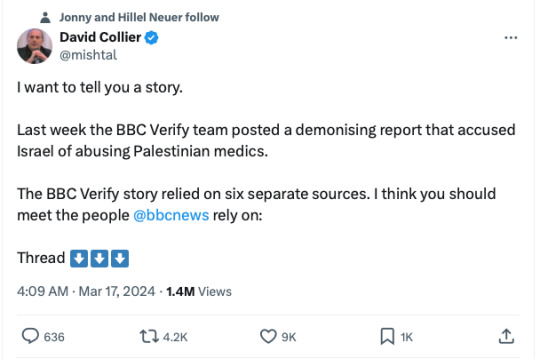
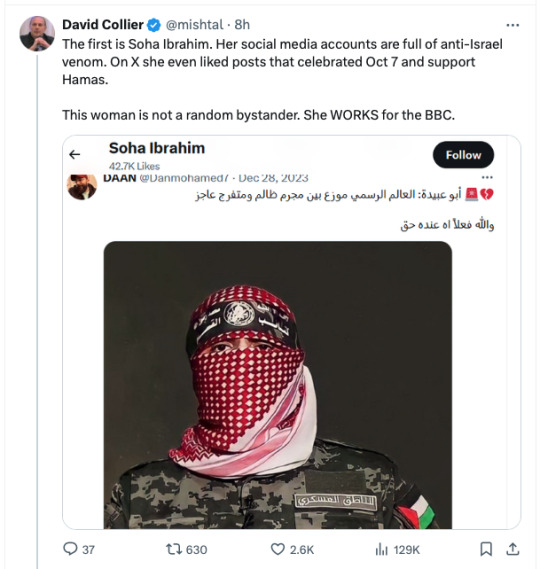


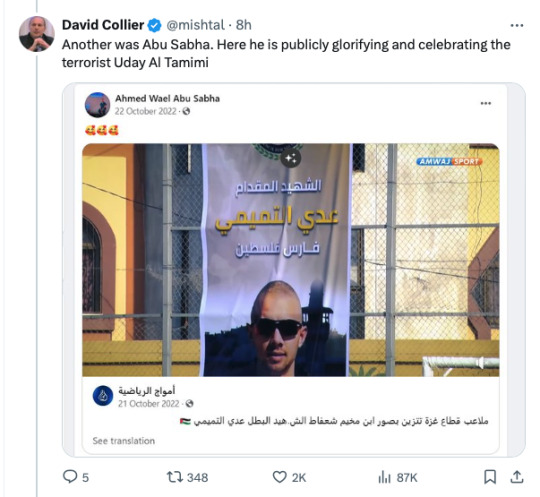

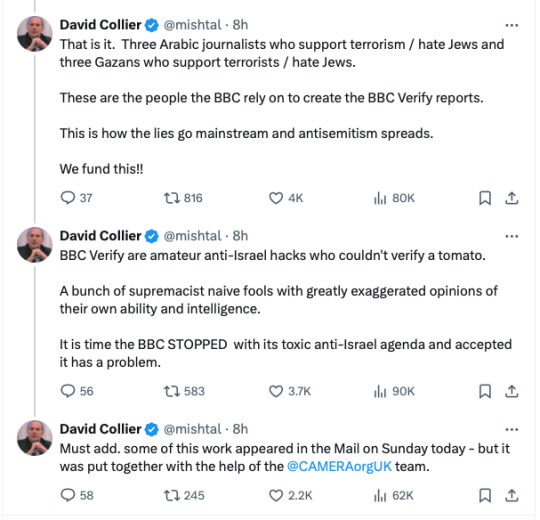
Source
#hamas#gaza#david collier#bbc#bbc verify#abusing palestinian medics#hatem raba#soha ibrahim#abu sabha#bbc news
76 notes
·
View notes
Text

BBC News
Israel says it will expand its offensive across most of Gaza
AFP A Palestinian woman holding a child lines up for a hot meal at a food distribution point at the Nuseirat refugee camp in central Gaza.AFP
Israel's defence minister has announced its military will soon "vigorously" expand its offensive throughout most of Gaza.
Israel Katz also said the Israel Defense Forces (IDF) had completed the takeover of a "security zone" in the southern part of the Gaza Strip, separating the cities of Rafah and Khan Younis.
Israel's military also issued evacuation orders for Khan Younis and its surrounding areas, saying it was preparing to carry out strikes in response to the launch of projectiles from Gaza, which Hamas has claimed responsibility for.
Israel resumed its offensive against Hamas on 18 March following the collapse of a two-month ceasefire.
Since then, it has seized large areas of Gaza, displacing hundreds of thousands of Gazans once more.
......
Where do we go from here?
I'm running on empty, no money, no strength, no will to keep pretending I’m okay.
Everything feels heavy, like I'm trapped in a nightmare I can't wake up from.
When does it end?
I just want to open my eyes and find peace… even just for a moment.
more information, please click here
✅️Vetted by @gazavetters, my number verified on the list is ( #15 )✅️
Also supported by @nabulsi Here. Here
💗 @a-shade-of-blue 💗 avatar by 💖 @catnapdreams 💖
@oediex @bloodbornebutch @soft-sunbird @disasterhimbo @rainy-fog @barricadebops @qzcyborg @mrfeeshboyo @meglyfer
#free palestine#boost#life#gaza strip#free gaza#gaza#signal boost#gaza under attack#gaza genocide#i stand with palestine#bbc#bbc news#world news#news#breaking news
1K notes
·
View notes
Video
youtube
Let's talk about the BBC report and Ukraine....
#youtube#bbc reporting#Ukraine#Isreal#hamas#americans are intellectually lazy#we see something on social media#and don't even take basic steps to verify it
0 notes
Text
[BBC is UK State Media]
The British-based Syrian Observatory for Human Rights (SOHR) said 162 civilians have been killed in "field executions" in the region - a heartland of deposed president Bashir al-Assad, who also belongs to the Alawite sect.
An interior ministry source told the country's official news agency Sana that "individual violations" had occurred on the coast and pledged to put a stop to them.
BBC News has not been able to verify claims that the killings were committed by the forces of Syria's new rulers.
The total killed includes 13 women and five children, the SOHR told the AFP news agency.[...]
A curfew has been imposed in the cities of Homs, Latakia and Tartous, where the fighting has broken out, and the governor of Latakia has said all power to the province has been cut.
Earlier, BBC Verify confirmed two videos that showed a body being dragged behind a car in Latakia.
The violence has left the Alawite community in "a state of horror", a Syrian activist in the city told BBC Newshour.
7 Mar 25
792 notes
·
View notes
Text
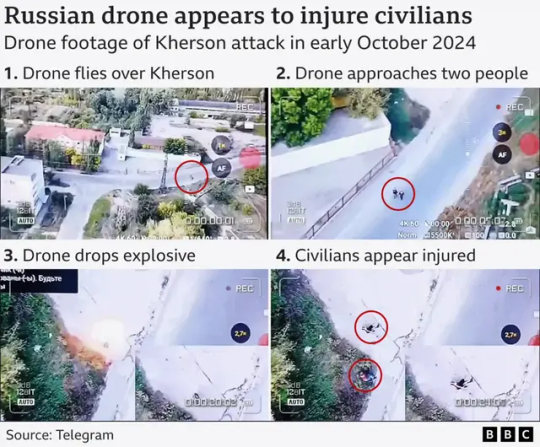
The BBC has finally picked up the story of the "human safari" russians are conducting in Kherson against the residents.
They report that since July 1, the city’s military administration have recorded more than 5,000 drone attacks with more than 400 civilians injured.
[The drone videos] were each posted with goading and threats to the Ukrainian public, including claims that all vehicles were legitimate targets and that people should minimise their public movement. The injured people were also insulted, called "pigs" or in one case mocked for being a woman.
If you want to read the BBC article and share it, you can find it below.
594 notes
·
View notes
Text
Hey!
The Bad Times are back!
For the next four years, it's going to be so much, all the time. The news is going to be so much, and the world is going to be so much, and it is going to suck.
We know this because we've seen it before.
It will be worse. It's already worse.
But we've also learned from last time--ways to resist, ways to protect each other, ways to protect ourselves.
Mask and get vaccinated (including a yearly flu shot), to protect yourself and the people around you. Verify sources and validate information before you share it. Follow reputable and reliable news sources like the Associated Press, the New York Times, and BBC. Be careful about what personal information you share about yourself and others, both online and in person--up to and including making sure not to out others without their permission.
But also take a deep breath. Hug a loved one. Pet a cat. Read a book.
We have a long four years ahead of us. We're not going to solve every problem right now.
Let's get through today.
302 notes
·
View notes